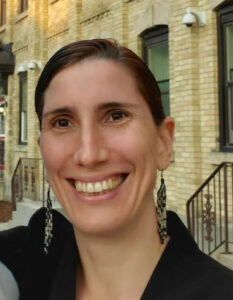Sunday, July 6, 2025
Fresh water is a finite resource vulnerable to contamination. Researchers from the University of Guelph (U of G) and scientists from the Canadian Light Source (CLS) at the University of Saskatchewan (USask) are developing low-energy strategies to purify polluted water.
“We’ve been looking at the purification of surface water, groundwater and wastewater,” says Erica Pensini, Associate Professor in the School of Engineering at U of G. “We found that it was possible to use molecules that are both water-loving and oil-loving to separate solvents from water.”
The team used the Mid-IR and Brockhouse beamlines to investigate the efficacy of their technique and visualize the ways the molecules interact. Their findings were recently published in Physics of Fluids.
“We can see little droplets that are starting to separate from the water and can understand how those molecules self-assemble and how they interact with each other,” says Pensini.
 Erica Pensini from the University of Guelph. Image credit: Canadian Light Source.
Erica Pensini from the University of Guelph. Image credit: Canadian Light Source.
Climate change is a threat to the world supply of fresh water. Pensini says that the amount of water on the planet has not changed, but the distribution of water has.
“We have to respond to the problem by minimizing withdrawals of water and also making sure that we don’t contaminate the water that is available to us,” says Pensini. “The idea is to make sure we can treat water to preserve water.”
The low-energy technique developed by Pensini and her collaborators can be used as an intermediary step or coupled with other low-energy purification techniques.
Pensini says CLS beamlines and the expertise of beamline scientist Jarvis Stobbs were invaluable resources for her and her collaborators, which for this study include Alejandro Marangoni (University of Guelph), Thamara Laredo (Lakehead University), and students Tatianna Marshall and Laura Earnden
“With the CLS, I can tell the purity of the droplets, and I don’t need to add any dye that can interfere with self-assembly,” says Pensini. “Not altering the samples at all was very important.”
The CLS is a national research facility of the University of Saskatchewan and one of the largest science projects in Canada’s history. More than 1,000 academic, government and industry scientists from around the world use the CLS every year in innovative health, agriculture, environment, and advanced materials research. The Canada Foundation for Innovation, Natural Sciences and Engineering Research Council, Canadian Institutes of Health Research, the Government of Saskatchewan, and the University of Saskatchewan fund CLS operations.
Featured image: Canadian Light Source (CLS) experimental facility from above. Credit: CLS/David Stobbe Photography.











